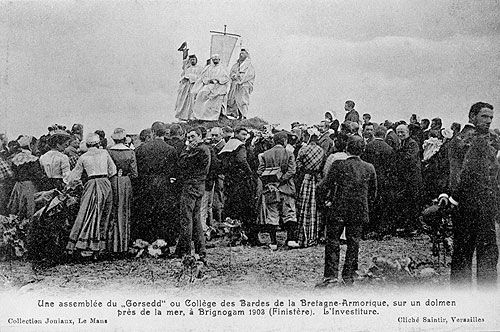Gorseddau outside Wales

The first public meeting of the Breton Gorsedd, Brignonan, 1903.
Gorseddau outside Wales
The ceremonies enacted in the Gorsedd Circle on Monday morning and again on the Eisteddfod stage in the afternoon, before the Crowning ceremony (since 1954), when the representatives of the Celtic nations and other friends are welcomed to the Gorsedd, are colourful and attractive ones. Usually there are representatives from Brittany, Cornwall, Ireland, Scotland, the Isle of Man, and also from Patagonia. Representatives of the Gorsedd of the Bards of the Isle of Britain attend their festivals in return. However, only two of the Celtic nations have a Gorsedd similar to that of Wales, namely Brittany and Cornwall. These are considered to be sub-Gorseddau and the Archdruid of the Welsh Gorsedd is the supreme head of them all.
The Breton Gorsedd
Interest in its Celtic heritage had re-kindled in Brittany after le Villemarqué's visit to Eisteddfod y Fenni (Abergavenny) in 1838 and the rite of marrying the two halves of the Split Sword was already popular before representatives from Brittany visited the Cardiff Eisteddfod in 1899. In 1900 a Breton Gorsedd - Gorsedd Barzed Gourenez Breiz-Izel - was established, with Ar Fusteg as Grand Druid and Taldir as Herald Bard. The Breton Gorsedd's first public ceremony was held at Brignonan in 1903.
However, for political and religious reasons, there has been considerable dissension within the Breton Gorsedd throughout its history. During the Second World War some Bretons, including Taldir, were accused of collaborating with the Vichy government and after the war had ended they were imprisoned. When Taldir was released he had to retire to north Africa and Eostig Sarzhaw was chosen as (vice) Grand Druid in his place. The dissension persisted and some members were drawn more towards Druidism and meetings at Stonehenge than towards the Welsh Gorsedd.
To quote Zonia Bowen on 'the tragic history' of the Breton Gorsedd, it has no '"raison d'être" such as the Welsh poetic tradition or an association with a body such as the National Eisteddfod.' Yet she emphasises that the Gorsedd as a society has survived longer than any other in the chequered history of the Breton nation.
The Grand Druid of Brittany wears a silver crown of mistletoe leaves.
The Gallic Gorsedd
Founded in 1923 on the basis that Gaul was a Celtic region before the Roman conquest, but by 1939 the Gorsedd had disappeared.
The Cornish Gorsedd:
Since the beginning of the twentieth century there had been somewhat of a revival in interest in the Cornish language, especially through the work of Henry Jenner, Keeper of Manuscripts at the British Museum. Several 'Old Cornwall' societies were formed and at the Treorchy Eisteddfod, in 1928, eight Cornishmen were accepted as members of the Gorsedd of the Bards. In September 1928 the first ceremony of the Cornish Gorsedd - Gorseth Kernow - was held at Boscawen Un, and Henry Jenner was invested as the first Grand Bard of Cornwall. The Cornish Gorsedd has only one order, the Order of Bards, wearing blue robes. The Grand Bard wears a crown of oak leaves and a breastplate.
The Gorsedd of North America
The sub-Gorsedd of North America was established by Archdruid Dyfed during the Pittsburgh Eisteddfod in 1913 and its Vice-Archdruid was Thomas Edwards - Cynonfardd, from Landore in Swansea. By 1946 the Gorsedd had been abolished.
The Gorsedd of Patagonia
Gutyn Ebrill (Griffith Griffiths, 1829-1909) established the Gorsedd of the Bards in Patagonia. Caeron (W.H.Hughes) and Prysor (William Williams) held office after Gutyn Ebrill but they considered themselves to be vice-Archdruids, under the authority of the Archdruid of Wales. After Prysor died in 1945 it seemed likely that the Patagonian Gorsedd would disappear for ever. Then, at the beginning of the twenty-first century during Meirion's period as Archdruid it was revived and representatives began to attend the National Eisteddfodau and Gorseddau of Wales once more.
Comments - (1)